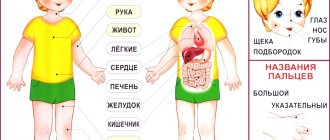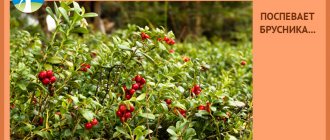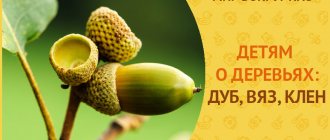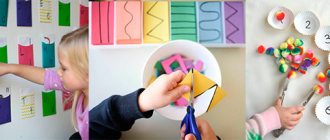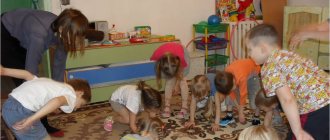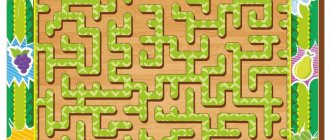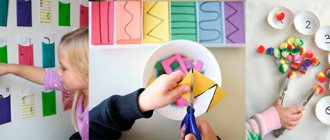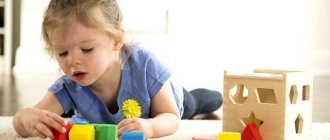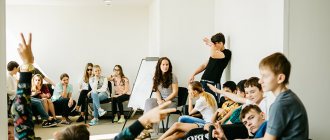The level of development of speech and cognitive abilities of preschoolers aged 4-5 years is already quite high: children actively communicate, have an extensive vocabulary that they can use in any situation, calmly describe a variety of objects, and obvious defects disappear from their speech. If this does not happen, then the likelihood of a diagnosis of speech development delay (speech development delay) increases several times. An examination by specialized specialists will help determine the cause of the delay and guide parents along the right path. At this age, the problem is not yet critical and can be eliminated with a competent combination of treatment (if necessary), speech development classes with a speech pathologist and classes with the participation of parents at home.
Norms of speech development at the age of 4-5 years
In order to timely identify problems with speech development, it is necessary to navigate what the baby should be able to do, and only after that “sound the alarm” by turning to speech therapists and speech pathologists. According to the norms of speech development for children from 4 to 5 years old, at this age a child should be able to:
- speak in such a way that everyone around you understands him, not just those closest to you;
- calmly operate with your vocabulary (minimum 3000 words); build logical sentences from 6-8 phrases;
- understand the difference between people, animals and inanimate objects, know their characteristics and distinctive features (animals cannot speak, a dog has four legs, a cat meows, etc.);
- be able to find an object, focusing only on its description (for example, a ball - round, blue, bouncy) and create descriptions of objects yourself;
- understand the meaning of prepositions and insert them correctly into sentences;
- have an understanding of different professions, who does what (teacher - teaches children, pastry chef - bakes cakes, etc.);
- be able to maintain a conversation on topics that he understands, ask relevant questions and answer questions put to him;
- retell heard stories, fairy tales, and entertaining stories without difficulty;
- know by heart simple rhymes, nursery rhymes, tongue twisters for children; state your first and last name without prompting, know your age and residential address;
- be able to answer questions about your pastime (where you were, what you ate for breakfast, who you met on the way to kindergarten, etc.).
Diagnostics of ZZR
Diagnosis of mental disorders includes checking the following indicators: pronunciation of sounds;
- sound-syllable structure of the word;
- phonetic sensitivity;
- possibilities of phonemic analysis of synthesis;
- the state of vocabulary and grammatical structure of impressive, expressive and coherent speech.
Based on the test data, the speech therapist draws up a diagnostic card describing the features of the child’s speech development, on the basis of which a conclusion is made and recommendations are made regarding speech development classes.
Middle group - how to play with children
Children in this age group are a little more persistent, so they are able to play with objects that require more attention and patience. As a rule, developing games are ideal at this age, where it is necessary to build more complex structures of houses, as well as various figures from the construction set. Role-playing games with dolls and various characters are perfect. Invite children to transform themselves into various fairy-tale characters, people of different professions, and animals. All this enriches their daily play in kindergarten.
In the middle group of preschool educational institutions, children can be offered complex furniture, as well as clothes for their dolls. Furniture can be created from construction sets and special cubes. This is a more difficult task, but it allows you to reveal the deep capabilities of the baby and teach him patience and perseverance when performing difficult tasks. This quality will be very useful in life, as well as at school. It is recommended to purchase doll furniture in different sizes - for dolls of different heights, a set for small dolls and a set of large furniture that are installed on the floor of the play area.
For training, you can use cards with inscriptions, posters, various visual aids, counting material, didactic sets and sets of Voskobovich, Nikitin, Montessori materials.
In general, at this stage, games are somewhat more complex and require deeper thinking, which enhances the child’s ability to learn.
What type of toys should the middle group of kindergarten be equipped with:
- Wooden construction sets and blocks for free modeling on the floor and table.
- Wooden or plastic construction sets on social themes: city, transport, farm, zoo, auto repair shop.
- Construction sets based on fairy tales with more complex plots: “The Wolf and the Seven Little Goats”, “The Three Little Pigs”, etc.
- Complex construction sets of various types and from different materials: construction set-house, Lego-type construction set, construction sets made of soft polymer, cardboard and plywood. Plastic construction sets with various types of fastenings.
- Cubes based on the “add the picture” principle, lotto, dominoes.
- Car rides and animal rides for outdoors and indoors.
- Educational toys: complex pyramids of the “Steps” type, logical mosaics of various types, “Geometric”, sticking cylinders, maze boards, lacing of various types and materials.
- Role-playing games: store, clinic (hospital), workshop, beauty salon, post office and others. In the middle group, the corners should be more complex. Filling for these areas: household children's appliances, food models, supermarket baskets, cash register, scales and much more.
- Dolls, cars and other toys based on gender (toys for boys and toys for girls). Airplanes, boats, figurines of people and animals, dolls, strollers, cribs and furniture, construction tools and more.
- Corner for nature observations, scientific wholesale and research (thermometer, cups, magnifying glass, experiment kits, trays, pipettes and other materials).
- Light table with colored sand, kinetic sand.
- Puzzles for children by age (tangram, Columbus egg, snake and others)
- Didactic materials for teachers: fun geometry, complex puzzles, sets for fine sorting, tactile circles, mathematical scales, magic bags, fold a square, Tetris, cut pictures, manuals for clocks of various types, counting material, nesting dolls, educational cards with pictures and more .
- Theatrical activities: puppet theater en ruku, puppet mittens, finger theater, shadow theater, walking theater and more.
- A set of games and toys for the street: buckets, shovels, scoops, molds, rakes, sand mill, jump ropes, horses on a stick, rolling cars and more.
- Set for sports games: ring throws, children's bowling or skittles, jump ropes, balls of different sizes, massage equipment (paths, traces, paths, hand balls), cones with gymnastic sticks, arches for climbing and more.
- Arts corner: notebooks, albums, pencils, plasticine, various types of paints and more.
- Musical toys: spoons, rattles, xylophone, maracas, pipes, accordion and more.
You can contact our specialists and they will select toys that suit your needs, based on documents from the Ministry of Education and Science of the Russian Federation. Write to us by email - [email protected]
We publish a document from the Ministry of Education and Science of the Russian Federation, which is recommended for use in kindergartens:
Didactic games
Didactic games for speech development for children 4-5 years old are varied, let’s look at the most popular ones.
- Find the mistake
This game allows you to correctly pronounce and remember words that have many words, and also actively develop auditory attention. For example, a child is shown a card of a baby elephant and told: he has a trunk (true), he runs fast (not true), he is heavy (true). In addition to the characteristics mentioned above, the child is asked to name a few more.
- That may or may not be the case
Thanks to this game, children learn to notice inconsistencies and actively develop their logical thinking. In individual sentences or short stories, it is necessary to identify what cannot be. For example: “Autumn has come and the first green leaves have begun to appear on the trees.”
- What season
Through poetry and descriptive stories, one can learn to identify the seasons very easily.
- Which, which, which
For a word that an adult asks for, it is necessary to choose the correct definition. For example: “The sun is yellow, hot, round”, “Snow is white, wet, cold”, “The hat is new, blue, warm.”
- Guess the plant
Independently describing objects and guessing what is described by an adult allows you to develop attention and memory, learn to correctly describe objects and guess them based on their characteristics.
- What happens
The child is asked to tell what could be, for example, blue - the sky, sea, mother's eyes, or tall - a fence, a house, a tree. Such activities help not only to develop attention, but also to develop the ability to classify objects according to different criteria: shape, color, etc.
- When does this happen
The child is presented with pictures that depict different actions (for example, it is snowing). It is necessary to determine when this happens (the correct answer is in winter).
Most didactic games are used by kindergarten teachers in accordance with the current Federal State Educational Standards, which are aimed at the active development of speech in preschool children. A complete list of all kinds of didactic games and various exercises (with detailed instructions) can be found in Programs for the development of speech and cognitive abilities for children 4-5 years old by different authors (Karpova S.I., Mamaeva V.V., Ushakova O.S.).
S.I. Karpova V.V. Mamaeva Development of speech and cognitive abilities of preschoolers 4-5 years old
Ushakova O.S. Speech development program for preschool children
Didactic games for children 4-5 years old card index (middle group) on the topic
Didactic games for children 4-5 years old
“Who talks like that?”
Goal: expanding vocabulary, developing reaction speed.
Progress: the teacher throws the ball to the children one by one, naming the animals. Children, returning the ball, must answer how this or that animal gives a voice: A cow moos A tiger growls A snake hisses A mosquito squeaks A dog barks A wolf howls A duck quacks A pig grunts Option 2. The speech therapist throws the ball and asks: “Who is growling?”, “Who is it?” moos?", "Who barks?", "Who cuckoos?" etc.
"Who lives where?"
Goal: to consolidate children’s knowledge about the homes of animals and insects. Consolidating the use of the grammatical form of the prepositional case with the preposition “in” in children’s speech.
Progress: Throwing the ball to each child in turn, the teacher asks a question, and the child, returning the ball, answers. Option 1. teacher: - Children: Who lives in a hollow? - Squirrel. Who lives in a birdhouse? - Starlings. Who lives in the nest? - Birds. Who lives in the booth? - The dog. Who lives in the hive? - Bees. Who lives in the hole? - Fox. Who lives in the lair? -Wolf. Who lives in the den? - A bear. Option 2. teacher: - Children: Where does the bear live? - In a den. Where does the wolf live? - In the lair. Option 3. Work on the correct sentence construction. Children are asked to give a complete answer: “The bear lives in a den.”
"Give me a word"
Goal: development of thinking, speed of reaction.
Progress: the teacher, throwing the ball to each child in turn, asks: “The crow is croaking, and what about the magpie?” The child, returning the ball, must answer: “The magpie is chirping.” Examples of questions: – An owl flies, but what about a rabbit? - The cow eats hay, and the fox? - The mole digs holes, and the magpie? - The rooster crows, and the chicken? - The frog croaks, and the horse? - The cow has a calf, and the sheep? – The bear cub has a mother bear, and the baby squirrel?
“Who moves how?”
Goal: enrichment of children’s verbal vocabulary, development of thinking, attention, imagination, dexterity.
Move: the teacher, throwing the ball to each child, names an animal, and the child, returning the ball, pronounces a verb that can be attributed to the named animal. teacher: -Children: Dog - stands, sits, lies, walks, sleeps, barks, serves (cat, mouse...)
"Hot Cold"
Goal: to consolidate in the child’s mind and vocabulary the opposite characteristics of objects or antonym words.
Move: the teacher, throwing the ball to the child, pronounces one adjective, and the child, returning the ball, calls another - with the opposite meaning. teacher: -Children: Hot-cold Good-bad Smart-stupid Cheerful-sad Sharp-dull Smooth-rough
“What happens in nature?”
Goal: to consolidate the use of verbs in speech, agreement of words in a sentence.
Move: the teacher, throwing the ball to the child, asks a question, and the child, returning the ball, must answer the question asked. It is advisable to play the game by topic. Example: Theme “Spring” teacher: -Children: The sun - what is it doing? - It shines, it warms. Streams - what are they doing? -They are running and murmuring. Snow - what does it do? — It’s getting dark, melting. Birds - what are they doing? - They fly in, build nests, sing songs. Drops - what does it do? - It rings and drips. The bear - what does it do - wakes up, crawls out of the den.
“Who can perform these actions?”
Goal: activation of children’s verbal dictionary, development of imagination, memory, dexterity. Move: the teacher, throwing the ball to the child, names the verb, and the child, returning the ball, names the noun that matches the named verb. Teacher: - Children: There goes a person, an animal, a train, a steamship, rain... A stream runs, time, an animal, man, road... A bird flies, a butterfly, a dragonfly, a fly, a beetle, an airplane... A fish, a whale, a dolphin, a boat, a ship, a man floats...
“What is it made of?”
Goal: to consolidate the use of relative adjectives and methods of their formation in children’s speech.
Move: the teacher, throwing the ball to the child, says: “Boots made of leather,” and the child, returning the ball, answers: “Leather.” Teacher: -Children: Mittens made of fur, basin made of copper, vase made of crystal, mittens made of wool-woolen
"Put it into pieces"
Goal: orientation in space.
Move: Fyodor’s character asks the guys to help her: put pots and pans on the bottom shelf, plates, spoons, knives and forks on a higher shelf, and saucers and jugs on the top shelf.
“Who was who?”
Goal: development of thinking, expansion of vocabulary, consolidation of case endings.
Move: the teacher, throwing the ball to one of the children, names an object or animal, and the child, returning the ball to the speech therapist, answers the question of who (what) the previously named object was: Chicken - egg Bread - flour Horse - foal Wardrobe - board Cow – calf Bicycle – iron Dud – acorn Shirt – cloth Fish – egg Boots – leather Apple tree – seed House – brick Frog – tadpole Strong – weak Butterfly – caterpillar Adult – child
“Which vegetable?”
Goal: development of tactile, visual and olfactory analyzers.
Procedure: the teacher cuts the vegetables, the children smell and taste them. The teacher gives an example: “The tomato is sweet, but the garlic is spicy.”
“What does it sound like?”
Goal: development of auditory attention and observation.
Procedure: the teacher behind the screen plays various musical instruments (tambourine, bell, wooden spoons). Children must guess what it sounds like.
“What happens in the fall?”
Purpose: to teach the seasons, their sequence and main features.
Progress: on the table are mixed pictures depicting various seasonal phenomena (it is snowing, a flowering meadow, an autumn forest, people in raincoats and with umbrellas, etc.). The child chooses pictures that depict only autumn phenomena and names them.
“What’s missing?”
Goal: development of attention and observation.
Procedure: the teacher places 4 vegetables on the table: “Children, look carefully at what is on the table. These are onions, cucumbers, tomatoes, peppers. Look carefully and remember. Now close your eyes.” Children close their eyes, and the teacher removes one vegetable. “What’s missing?” Children remember and name the vegetable.
“Catch and throw – name the colors”
Goal: selection of nouns for the adjective denoting color. Reinforcing the names of primary colors, developing children's imagination.
Move: the teacher, throwing the ball to the child, names an adjective denoting color, and the child, returning the ball, names a noun that matches this adjective. teacher: - Children: Red - poppy, fire, flag Orange - orange, carrot, dawn Yellow - chicken, sun, turnip Green - cucumber, grass, forest Blue - sky, ice, forget-me-nots Blue - bell, sea, sky Violet - plum , lilac, dusk
"Whose head?"
Goal: expanding children's vocabulary through the use of possessive adjectives. Move: the teacher, throwing the ball to the child, says: “A crow has the head...”, and the child, throwing the ball back, finishes: “... a crow.” For example: A lynx has a lynx's head. Fish - fishy Cat - feline In a magpie - magpie In a horse - equine In an eagle - eagle In a camel - camel
"The Fourth Wheel"
Goal: to consolidate children’s ability to identify common features in words and develop the ability to generalize.
Procedure: the teacher, throwing the ball to the child, names four words and asks them to determine which word is the odd one out. For example: blue, red, green, ripe. Zucchini, cucumber, pumpkin, lemon. Cloudy, stormy, gloomy, clear.
"One is many"
Goal: to consolidate various types of endings of nouns in children’s speech.
Progress: the teacher throws the ball to the children, calling singular nouns. Children throw the ball back, naming plural nouns. Example: Table - tables chair - chairs Mountain - mountains leaf - leaves House - houses sock - socks Eye - eyes piece - pieces Day - days jump - jumping Sleep - dreams gosling - goslings Forehead - foreheads tiger cub - cubs
"Pick up the signs"
Goal: activation of the verb dictionary.
Progress: the teacher asks the question “What can squirrels do?” Children answer the question and find a picture for the question asked. Sample answers: Squirrels can jump from branch to branch. Squirrels know how to make warm nests.
"Animals and their young"
Goal: to consolidate the names of baby animals in children’s speech, consolidate word formation skills, develop dexterity, attention, and memory.
Move: throwing the ball to the child, the teacher names an animal, and the child, returning the ball, names the baby of this animal. The words are arranged into three groups according to the method of their formation. The third group requires memorizing the names of the cubs. Group 1. The tiger has a tiger cub, the lion has a lion cub, the elephant has a cub, the deer has a fawn, the elk has a calf, the fox has a fox calf. Group 2. The bear has a baby bear, the camel has a baby camel, the hare has a baby hare, the rabbit has a baby rabbit, the squirrel has a baby squirrel. Group 3. The cow has a calf, the horse has a foal, the pig has a piglet, the sheep has a lamb, the hen has a chick, the dog has a puppy.
“What is round?”
Goal: expanding children's vocabulary through adjectives, developing imagination, memory, and dexterity.
Move: the teacher, throwing the ball to the children, asks a question; the child who caught the ball must answer it and return the ball. -What is round? (ball, ball, wheel, sun, moon, cherry, apple...) - what is long? (road, river, rope, tape, cord, thread...) - what is tall? (mountain, tree, rock, person, pillar, house, closet...) - what is prickly? (hedgehog, rose, cactus, needles, Christmas tree, wire...)
"Pick up a word"
Goal: development of word formation skills, selection of related words. For example, bee - bee, little bee, beekeeper, beekeeper, bees, etc.
"Generalizing concepts"
Goal: expansion of vocabulary through the use of generalizing words, development of attention and memory, ability to correlate generic and specific concepts.
Option 1. Move: the teacher names a generalizing concept and throws the ball to each child in turn. The child, returning the ball, must name the objects related to that generalizing concept. teacher: -Children: Vegetables - potatoes, cabbage, tomato, cucumber, radish
. Option 2. The teacher names specific concepts, and the children name generalizing words. teacher: Children: Cucumber, tomato-Vegetables.
"Good bad"
Goal: introducing children to the contradictions of the world around them, developing coherent speech and imagination.
Progress: the teacher sets the topic of discussion. Children, passing the ball around, tell what, in their opinion, is good or bad in weather phenomena. Teacher: Rain. Children: Rain is good: it washes away dust from houses and trees, it is good for the earth and the future harvest, but it is bad - it wets us, it can be cold. Teacher: City. Children: It’s good that I live in the city: you can travel by subway, by bus, there are a lot of good shops, but the bad thing is that you won’t see a live cow or rooster, it’s stuffy, dusty.
"Near and Far"
Goal: development of auditory attention, hearing acuity.
Progress: the teacher behind the screen produces sound with a large or small toy. Children determine the size of the toy (large or small) by the strength of the sound.
"Call me kindly"
Goal: strengthening the ability to form nouns using diminutive suffixes, developing dexterity and speed of reaction.
Move: the teacher, throwing the ball to the child, calls the first word (for example, ball), and the child, returning the ball, calls the second word (ball). Words can be grouped by similar endings. Table-table, key-key. Beanie hat, squirrel squirrel. Book-book, spoon-spoon. Head-head, picture-picture. Soap-soap, mirror-mirror. Doll-doll, beet-beet. Braid-braid, water-water. Beetle-beetle, oak-oak. Cherry-cherry, tower-tower. Dress-dress, chair-chair.
"Fun account"
Goal: to consolidate the agreement of nouns with numerals in children’s speech.
Move: the teacher throws the ball to the child and pronounces a combination of a noun with the numeral “one”, and the child, returning the ball, in response calls the same noun, but in combination with the numeral “five”, “six”, “seven”, “eight”. Example: One table - five tables One elephant - five elephants One crane - five cranes One swan - five swans One nut - five nuts One cone - five cones One gosling - five goslings One chicken - five chickens One hare - five hares One hat - five caps One can – five cans.
“Guess who called?”
Goal: distinguishing the most abbreviated sound complexes by timbre.
Move: the driver turns his back to the children and uses the “pee-pee” sound complex to determine who called him. The child the teacher points to calls the driver.
Didactic games aimed at developing elementary mathematical concepts in children of the second junior group
"Find the object"
Goal: learn to compare the shapes of objects with geometric patterns.
Material. Geometric shapes (circle, square, triangle, rectangle, oval).
The children stand in a semicircle. In the center there are two tables: on one there are geometric shapes, on the second there are objects. The teacher explains the rules of the game: “We will play like this: whoever the hoop rolls to will come to the table and find an object of the same shape as the one I show. The child to whom the hoop rolled comes out, the teacher shows the circle and offers to find an object of the same shape. The found object rises high, if it is chosen correctly, the children clap their hands. Then the adult rolls the hoop to the next child and offers a different shape. The game continues until all items match the samples.
"Merry dolls"
Goal: to teach to distinguish and compare objects according to different qualities of size. Material. 2 sets of five-seater nesting dolls, 2 sets of circles of different sizes, a turret made of hollow cubes.
At the invitation of the teacher, the children sit at a common table on which there is a nesting doll. The teacher turns to the children: “I want to play funny nesting dolls with you, but I see that there is only one nesting doll here, but where are the rest? (looks around, and then picks up a matryoshka doll and shakes it). Something is rattling in the middle! Let's see what's there? (Removes the upper half of the matryoshka doll). This turns out to be where they hid! (All nesting dolls are placed in a row). Let's get to know them! The teacher calls the name of each nesting doll, tilting it: “I am Matryosha, I am Natasha, I am Dasha, I am Masha,” etc. Each child chooses one of the nesting dolls (the teacher takes one matryoshka for himself). The game begins. First, the nesting dolls walk (walk on the table). Then they are called to measure height. They line up one after another and take turns, starting with the smallest one, standing according to height, and the teacher clarifies which nesting doll is the smallest (tallest)? Then the nesting dolls go to dinner. The teacher puts on the table a set of circles (plates) of five sizes, calls the children in turn, who select plates of the appropriate size for their nesting dolls. After lunch, the nesting dolls get ready for a walk. The teacher puts the second set of nesting dolls on the table, and the children select girlfriends of the same height for their nesting dolls. Pairs of nesting dolls move around the table. Then they run away and mingle. (“The nesting dolls wanted to run”). Unnoticed by the children, the teacher removes a pair of nesting dolls of the same height from the table. "Time to go home! - says the teacher. Get into pairs." The nesting dolls are lined up in pairs, and suddenly it turns out that a certain pair of nesting dolls is missing. The teacher invites the children to call the nesting dolls by name (if they remember). Everyone asks her to come back in unison. The nesting dolls appear, the kids put them in place and the toys go home. The teacher puts on the table a tower made of hollow cubes (one side is missing) - these are houses for nesting dolls. At the request of the teacher, each child finds a home for his nesting doll. The nesting dolls bow, say goodbye and go home.
"Long - short"
Goal: to develop in children a clear differentiated perception of new qualities of size.
Material. Satin and nylon ribbons of different colors and sizes, cardboard strips, story toys: a fat bear and a thin doll.
Before starting the game, V. lays out sets of gaming didactic material (multi-colored ribbons, stripes) on two tables in advance. The teacher takes out two toys - a teddy bear and a Katya doll. He tells the children that Misha and Katya want to be dressed up today, and for this they need belts. He calls two children and gives them ribbons rolled into a tube: one short - a belt for Katya, the other long - a belt for a bear. Children, with the help of V., try on and tie belts for toys. The toys express joy and bow. But then the toys want to change belts. The teacher suggests taking off the belts and changing their toys. Suddenly he discovers that the doll’s belt doesn’t fit on the bear, and the belt is too big for the doll. The teacher offers to examine the belts and spreads them side by side on the table, and then places a short ribbon on a long one. He explains which ribbon is long and which is short, i.e. he gives the name for the quality of quantity - length. After this, V. shows the children two cardboard strips - a long one and a short one. Shows children how to compare strips with ribbons by overlapping them and tell which one is short and which one is long.
"Pick a figure"
Goal: to consolidate children’s ideas about geometric shapes and practice naming them.
Material. Demonstration: circle, square, triangle, oval, rectangle, cut out of cardboard. Handout: cards with outlines of 5 geometric lottos.
The teacher shows the children the figures and traces each one with his finger. Gives a task to the children: “You have cards on your tables with figures of different shapes on them, and the same figures on trays. Place all the figures on the cards so that they are hidden.” Asks the children to trace each figure lying on the tray, and then places (“hide”) it on the drawn figure.
"Three squares"
Goal: to teach children to correlate three objects by size and indicate their relationships with the words: “big”, small”, “medium”, largest”, “smallest”.
Material. Three squares of different sizes, flannelgraph; Children have 3 squares, flannel.
Teacher: Children, I have 3 squares, like these (shows). This one is the biggest, this one is smaller, and this one is the smallest (each of them shows). Now show the largest squares (children pick them up and show them), put them down. Now raise the averages. Now - the smallest ones. Next, V. invites the children to build towers from the squares. Shows how this is done: places on the flannelgraph from bottom to top, first a large, then a medium, then a small square. “Make such a tower on your flannelographs,” says V.
"Hoop Game"
Goal: distinguishing and finding geometric shapes.
For the game, 4-5 story toys are used (doll, nesting dolls, basket, etc.); differing in size, color, shape. The toy is placed in a hoop. Children identify the characteristics characteristic of the toy, put into the hoop those geometric shapes that have a similar characteristic (all red, all big, all round, etc.) Outside the hoop are figures that do not have the selected characteristic (not round, not big, etc.) d.)
Geometric Lotto
Goal: to teach children to compare the shape of the depicted object with a geometric figure and to select objects according to a geometric pattern.
Material. 5 cards with images of geometric shapes: 1 circle, square, triangle, rectangle, oval. 5 cards each depicting objects of different shapes: round (tennis ball, apple, ball, soccer ball, balloon), square rug, scarf, cube, etc.; oval (melon, plum, leaf, beetle, egg); rectangular (envelope, briefcase, book, domino, picture).
5 children take part. The teacher reviews the material with the children. Children name figures and objects. Then, according to V.’s instructions, they select cards with images of objects of the desired shape for their geometric samples. The teacher helps children correctly name the shape of objects (round, oval, square, rectangular).
“What types of figures are there?”
Goal: to introduce children to new shapes: oval, rectangle, triangle, pairing them with already familiar ones: square-triangle, square-rectangle, circle-oval.
Material. Doll. Demonstration: large cardboard figures: square, triangle, rectangle, oval, circle. Handout: 2 pieces of each smaller shape.
The doll brings figures. The teacher shows the children a square and a triangle and asks what the first figure is called. Having received an answer, he says that there is a triangle in the other hand. The examination is carried out by tracing the contour with a finger. Draws attention to the fact that a triangle has only three angles. Invites children to pick up triangles and put them together. Similarly: a square with a rectangle, an oval with a circle.
"Wide - narrow"
Goal: to form a “broad - narrow” view.
The lesson is carried out in a similar way, but now children learn to distinguish the width of objects, i.e. wide and narrow ribbons of the same length. When creating a game situation, you can use the following game technique. Two cardboard strips are laid out on the table - wide and narrow (of the same length). A doll and a bear can walk along a wide strip (path), but only one of them can walk along a narrow strip. Or you can play the story with two cars.
"Which uniform for whom"
Option 1. Goal: to teach children to group geometric shapes (ovals, circles) by shape, distracting from color and size.
Material. Large bear and matryoshka. Handout: three circles and ovals of different colors and sizes, 2 large trays for each child.
The teacher demonstrates a circle and an oval, asks the children to remember the names of these figures, show how they differ from each other, and trace the contours with their fingers. “Now put all the circles on one tray - the nesting doll, all the ovals on the other - the bear.” The teacher observes how the children complete the task, and in case of difficulty, asks the child to circle the figure with his finger and say what it is called. At the end of the lesson, V. summarizes: “Today we learned to distinguish circles from ovals. The bear will take all the ovals to the forest, and the matryoshka will take the circles home.”
Option 2. Goal: to teach children to group geometric shapes (squares, rectangles, triangles) by shape, distracting from color and size. The content is the same as option 1.
"Let's collect beads"
Goal: to develop the ability to group geometric shapes according to two properties (color and shape, size and color, shape and size), to see the simplest patterns in the alternation of shapes.
Equipment. There is a long ribbon on the floor, on it, from left to right, in a certain alternation, figures are laid out: red triangle, green circle, red triangle, etc.
Children stand in a circle, in front of them are boxes with multi-colored geometric shapes. The teacher suggests making beads for the New Year tree. He points to a tape with laid out geometric shapes and says: “Look, the Snow Maiden has already started making them. What shapes did she decide to make the beads from? Guess which bead is next.” Children take two of the same figures, name them and begin to make beads. They explain why they lay out this particular figure. Under the guidance of the teacher, mistakes are corrected. Then V. says that the beads have scattered and need to be collected again. He lays out the beginning of the beads on the tape, and invites the children to continue. He asks which figure should be next and why. Children choose geometric shapes and arrange them in accordance with a given pattern.
"Our day"
Goal: to consolidate the idea of the parts of the day, to teach how to correctly use the words “morning”, “day”, “evening”, “night”.
Equipment. Bibabo doll, toy bed, dishes, comb, etc.; pictures showing children's actions at different times of the day.
Children sit in a semicircle. The teacher, with the help of a doll, performs various actions by which children must determine the part of the day: the doll gets out of bed, gets dressed, combs its hair (morning), has lunch (afternoon), etc. Then V. names the action, for example: “The doll washes itself,” invites the child to perform it and name the part of the day corresponding to this action (morning or evening). The teacher reads an excerpt from Petrushina’s poem:
Doll Valya wants to sleep.
I'll put her to bed.
I'll bring her a blanket
To fall asleep faster.
Children put the doll to sleep and say when this happens. The teacher shows pictures in time sequence and asks what part of the day these actions occur. Then he mixes the pictures and, together with the children, places them in the order of the actions of the day. Children arrange their pictures in accordance with B’s pictures.
"Let's decorate the rug"
Goal: to develop the ability to group objects according to given characteristics and determine the number of objects.
Equipment. There are two square rugs on the floor, each of which is divided into 25 equal squares. The top row of each square depicts geometric shapes of different colors, a circle, a triangle, a square. Each of the children has three different geometric shapes.
Rug
The teacher says: “This is a rug. Let's decorate it together. We will place figures of the same shape and color one below the other. What figure should we put in this cell? (Points to an empty cell in the left column). After completing the work, the children and the teacher examine the decorated rug and note the uniformity of the figures in the columns (color, shapes). The teacher clarifies: “What are the figures in the left column? (Red triangles). And on the right? (Green squares).” Etc. Then the children decorate the second rug, showing greater independence. The teacher asks questions about the number, color, shape of the figures, and leads the children to the conclusion: “All the figures in the left column are triangles. That’s why Vova placed the circle incorrectly.” Etc.
"Make an object"
Goal: to practice composing the silhouette of an object from individual parts (geometric shapes).
Equipment. There are large toys on the table: a house, a tumbler, a snowman, a Christmas tree, a truck. There are sets of different geometric shapes on the floor.
The teacher offers to name the toys that are on his table and make any of them using a set of geometric shapes. Encourages and stimulates children's actions. He asks: “What did you make up? From what geometric shapes?” Children examine the resulting silhouettes of toys, remember the corresponding poems and riddles. It is possible to combine the composed silhouettes into a single plot: “House in the Forest”, “Winter Walk”, “Street”, etc.
Exercises and tasks
The main exercises and tasks that need to be done daily at home for the active development of coherent speech are:
Articulation gymnastics
- Eat some jam. You need to imagine that after eating the pie there is jam left on your lips that needs to be licked. Using your tongue, smoothly lick the jam from the lower and upper lips.
- Spade tongue. It is necessary to imagine that the tongue is a shovel, which should lie on the stand (lower lip) for as long as possible. We extend the tongue, placing it on the lower lip, and hold it in this position for 10-15 seconds.
- The tongue is a needle. You need to imagine that the tongue is a thin needle that needs to be held in place. We stretch out our tongue, trying to make it narrow, and try to hold it for 10-15 seconds.
- I'm a horse. The child needs to imagine himself as a horse that clatters its hoofs and clicks its tongue. We stomp our right and left feet in turn, clicking our tongue as we do so.
These exercises are best done for no more than 5-7 minutes and repeated 2 times a day.
It’s more fun to do articulation gymnastics with children by looking at pictures and reading rhymes.
Finger games
- Kitty. Both palms are clenched into fists and lie on a flat surface. It is necessary to simultaneously straighten the fingers on both handles, pressing them tightly to the table. The exercise must be repeated 4-5 times. After several lessons, the task can be complicated: first, the fingers on one hand are straightened, then they are compressed, and on the second they are straightened.
- Let's treat the cat with milk. Palms as if scooping out milk.
- Bunny. The fingers imitate the ears of a bunny, the fingers run along the table, clenched into a fist, fist in fist.
- Dog. The index finger shows the tail of the dog, the fingers are clenched into a fist, the thumb is raised up, the fingers run away.
Using finger games with parallel learning of rhymes can show quite good results, since there is a strong relationship between the human hand and the speech center of the brain. The baby easily and more emotionally perceives information and reproduces it in the future without problems.
Logorhythmics
Logorhythmics is the simultaneous reading of poetry, accompanied by a certain set of movements against the background of thematic music. Initially, the adult shows everything by example, after which the child is asked to repeat what he just saw.
The optimal time to complete this task is the second half of the day, the regularity of classes is every 1-2 days.
A special place in speech development classes is given to cartoons, which children love so much. There are specially designed cartoons aimed at reinforcing the letters of the alphabet, learning colors, learning to count and speech development.
The choice of cartoons remains up to the parents, but a prerequisite is its versatility (for both boys and girls), the presence of positive characters, and high quality video and sound.
Tongue Twisters
Tongue twisters for children are small rhyming phrases, often with a specific plot. Thanks to classes on tongue twisters, speech clarity is effectively developed and vocabulary is replenished. There are the following types of tongue twisters that are used during speech development classes:
- Containing the sound [L]: “The Christmas tree has needles, needles and pins at the Christmas tree,” etc.
- Containing sounds [Z], [Zh], [S], [Sh]: “Six mice in the reeds, ShurShat”, etc.
- Containing the sound [P]: “The beavers are going to the cheese forests. Beavers are kind, beavers are good”, etc.
- Containing the sounds [З] и [Зь]: “Zoya’s Bunny is called ZaZnayka”, etc.
Properly selected tongue twisters for speech development, provided regular practice, can significantly improve diction and develop competent speech.
If you do not approach the problem of children's speech development in a timely manner and with all seriousness, then in the near future they may have difficulties in learning at school and in communicating with classmates (due to incorrect pronunciation of sounds). This is fraught with ridicule, a decrease in the child’s self-esteem, and the disappearance of the desire to learn and communicate with others. Therefore, the development of speech in children aged 4-5 years should become a priority task for parents themselves, who can actively work with their children at home, in a playful way.
Progress of the game. The teacher explains the rules of the game:
— Today we have a new interesting game. It's called "Hunter and Shepherd"
.
Who is a hunter? Who knows? (Children answer.)
Yes, he hunts in the forest. Remember how wild
you know the animals.
- Hare, fox, wolf, bear, squirrel, tiger, the children list.
- Why are they called wild? - the teacher asks the children. - Right. Because they live in the forest, far from a person's home. So who hunts wild animals?
“Hunter,” the children answer in unison.
-Who is the shepherd? - the teacher asks the question again. - What animals does he graze?
The children answer, the teacher asks all the children to say in chorus the words domestic animals and wild animals.
So, the shepherd grazes domestic animals, and the hunter hunts wild animals. Now we will choose a shepherd and a hunter for the game. Who wants to be a hunter? And who is the shepherd? (To begin with, select children who are more active .)
Vitya is a shepherd, and Zhenya is a hunter. Okay. Now listen to the rules of the game: on this half of the flannelgraph, on the right there is a meadow where domestic animals graze, and on the left side there is a forest where wild animals live.
At the signal “Look!”
Vitya and Zhenya will take and put
pictures of animals on the flannelgraph. the pictures are selected correctly .
If someone makes a mistake, it means he is a bad shepherd or hunter. The shepherd and the hunter come to the table. "Look!"
- the teacher gives a signal. For the first time you should put a small number of animal species (4-5, next time you need to add 2-3 more species to complicate the task.
At the end of the game you can count how many wild animals and how many domestic animals. In the game, of cards with images of wild animals and domestic animals.
“What’s extra?”
Didactic task . Teach children to notice errors in the use of objects; develop observation skills, a sense of humor, and the ability to prove the correctness of one’s judgment; consolidate knowledge about working tools.
Game rule. Cover with cardboard only the picture that is superfluous. The first one to discover the unwanted item wins.
Game actions. Find and close unnecessary items.
Progress of the game. on large maps , and in the cells are the objects and tools they need for work. Among them there are those who are not needed for this profession. For example, in the center there is a drawing that depicts a nurse treating a patient, and in the cells are drawn all the objects necessary for her work, including dumbbells.
Children playing should notice and cover the unnecessary object with a clean square. Here you need to select pictures with professions familiar to children: cook, janitor, driver, combine operator, builder, teacher, salesman, etc. Children exchange cards and the game continues.
“When does this happen?”
Didactic task . To consolidate children's knowledge about the parts of the day ; exercise them in comparing pictures with parts of the day : morning, afternoon, evening, night.
Game rules. According to the word that the teacher says, show the card and explain why he picked it up.
Game action. Search for the desired picture .
Progress of the game. On the table the players have different pictures reflecting life in kindergarten; morning exercises, breakfast, games in the area, educational activities, sleep, cleaning the group room,
sledding, parents coming, etc. There should be several picture . Children each choose any picture and look at it carefully. When they hear the word morning, all the children pick up the picture and each one explains why he thinks it is morning: the children come to kindergarten, the teacher is waiting for them, they do morning exercises, wash, brush their teeth, have breakfast, study, etc. Then the teacher says word day. Pictures are raised who have an image of some event or activity of children at this time of day : on a walk, working on the site, having lunch, sleeping. "Evening"
, says the teacher, and the children raise the corresponding
cards .
- Why did you show this card ? - asks the teacher of the summoned child.
“Because the mothers came for the children, it’s dark outside,” he answers.
"Night"
“, says the teacher, and the children pick up
cards with images of sleeping children.
This is how children’s knowledge about the parts of the day . For each correct answer, children receive chips: pink chip - morning, blue - day, gray - evening, black - night.
Then all the cards are shuffled , and the game continues so that the words are called in the reverse order: the teacher says, for example, evening, and then morning, i.e., thereby increasing attention to the verbal signal.
Word games
“We won’t tell you where we were, but we’ll show you what we did.”
Folk game
Didactic task . Teach children to call an action a word; use verbs correctly (tense, person)
; develop creative imagination and ingenuity.
Game rule. All children correctly depict the action so that they can guess and name it.
Game actions. Imitation of movements, guessing; driver's choice.
